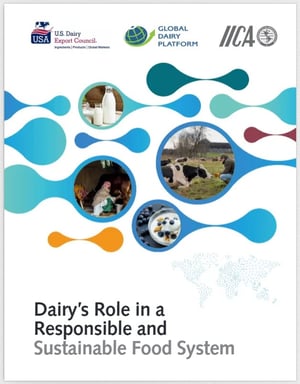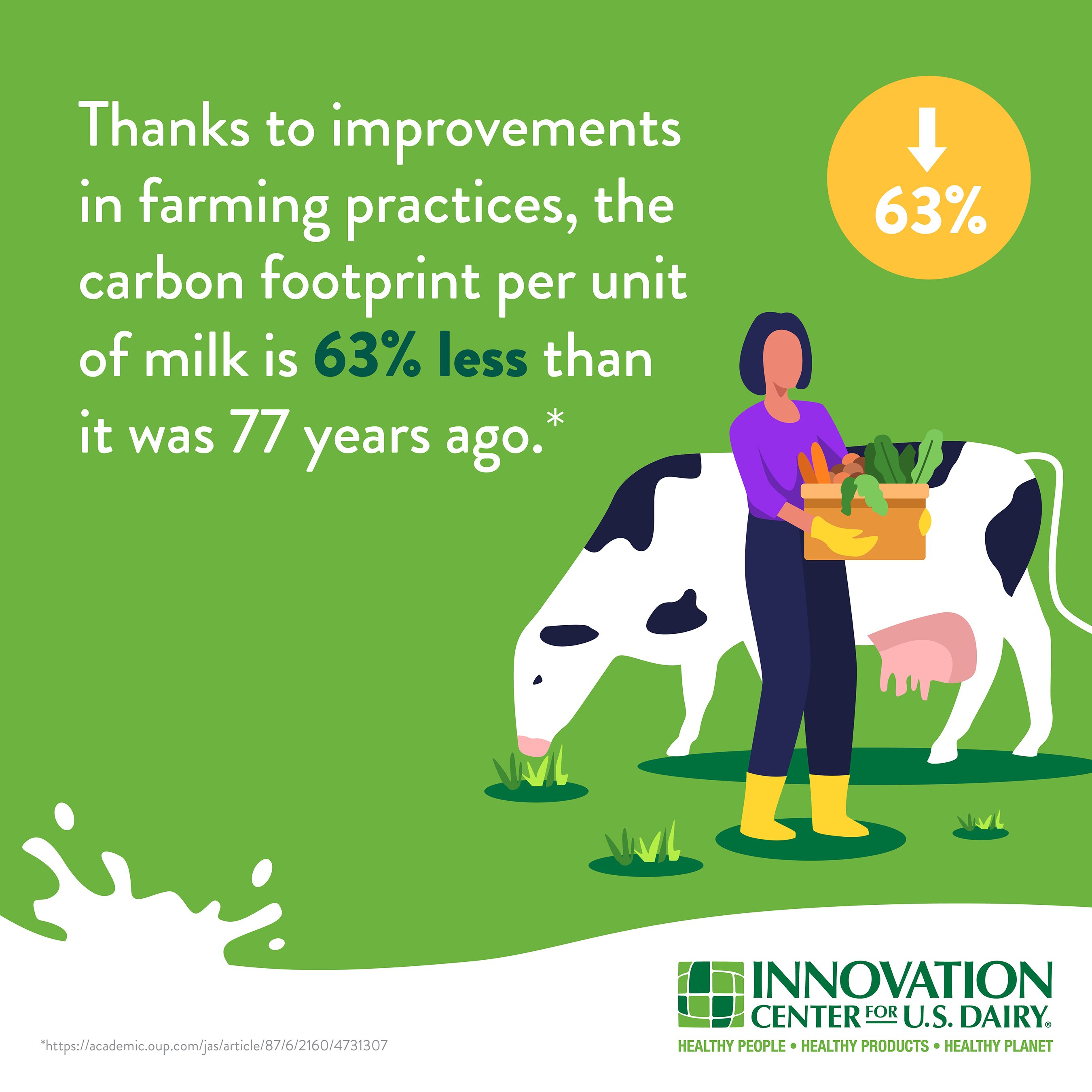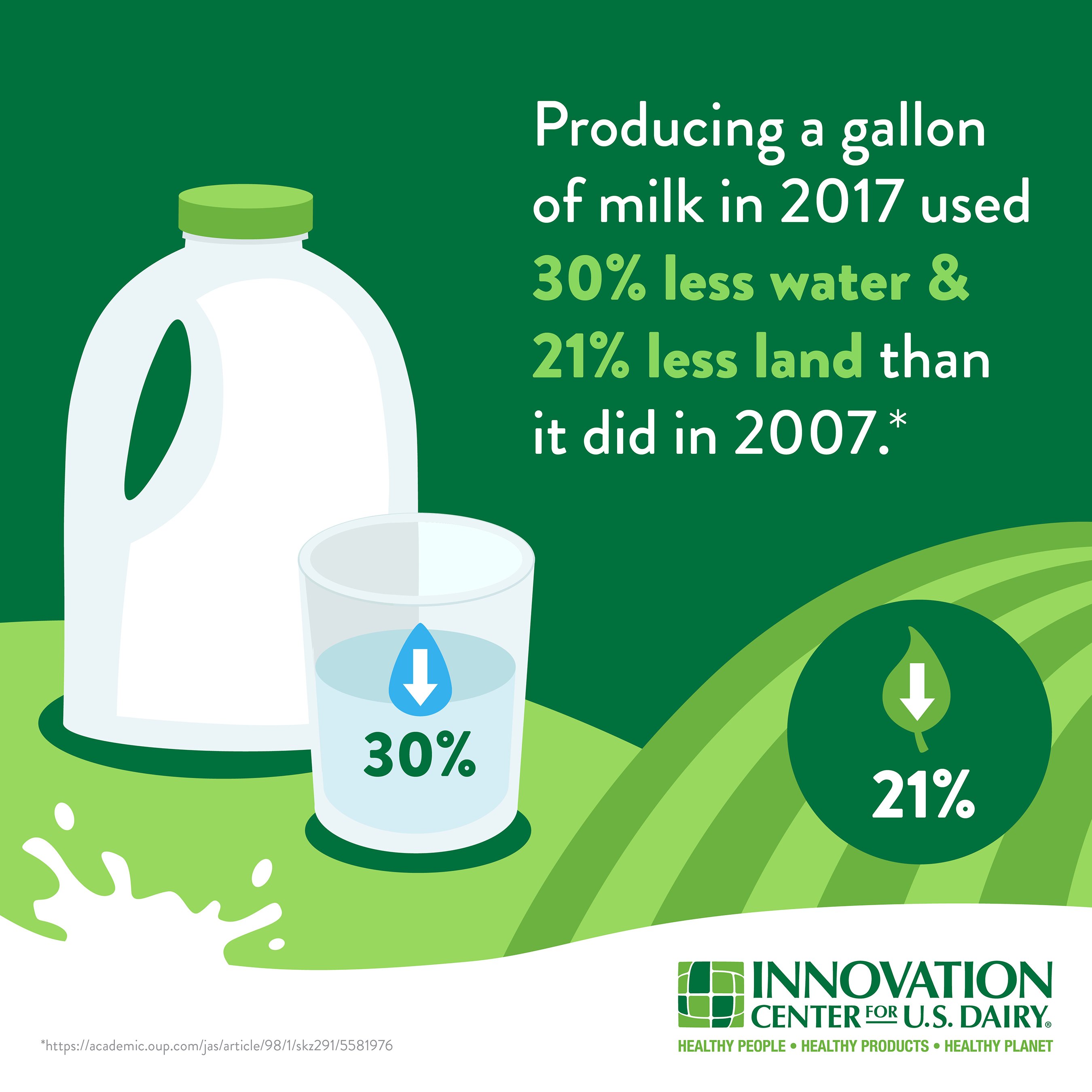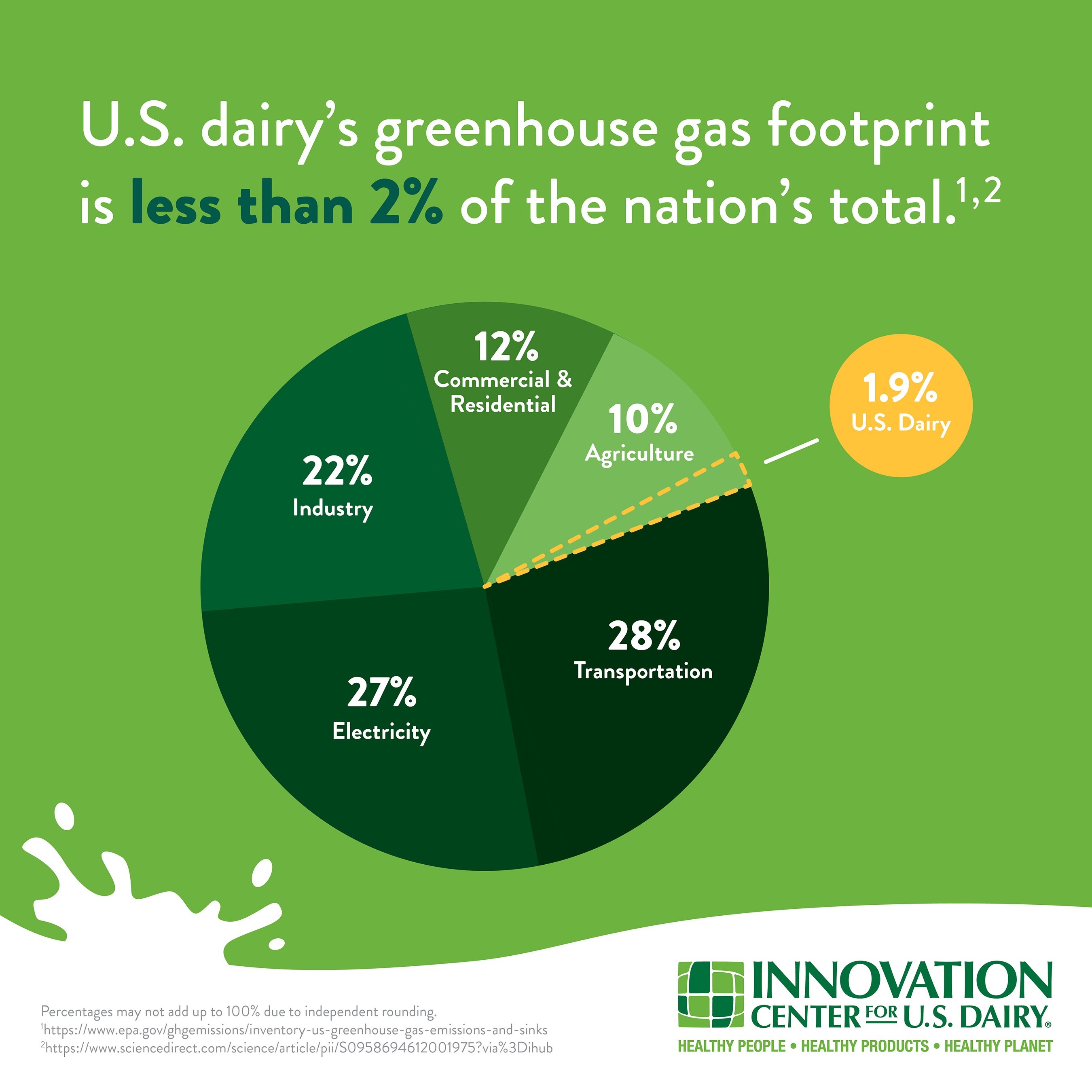-
Three reasons to applaud dairy on Earth Day
By USDEC April 20, 2021- Tweet
A new report shows how dairy fosters global food and economic sustainability. U.S. dairy has set an ambitious goal of being carbon neutral by 2050.
Thursday is Earth Day, which means anti-dairy activists will be out in force, making misleading claims on social media, devoid of appropriate context, demonizing cows and the dairy industry as bad for the planet.
The truth is that dairy has made significant progress and will continue to provide sustainable solutions in the future.
The U.S. dairy industry is in the global vanguard with a “Net Zero Initiative” committed to three environmental stewardship goals by 2050:
- Become carbon neutral or better.
- Optimize water use while maximizing recycling.
- Improve water quality by optimizing utilization of manure and nutrients.
“U.S. Dairy is making a promise for a better future,” says U.S. Dairy Export Council President and CEO Krysta Harden. “By expanding, operationalizing and measuring sustainability practices across farming and dairy companies, we’re harnessing the power of a strong, connected and diverse sector to nourish people, the planet and local communities.
“We’re putting a stake in the ground to say, ‘U.S. Dairy will give more than it takes.’”
New report documents role of global dairyThe Inter-American Institute for Cooperation on Agriculture, in collaboration with the U.S. Dairy Export Council and the Global Dairy Platform, hosted a virtual webinar in August about dairy and its role in sustainable food systems. It was attended by more than 500 participants across the Western Hemisphere.
On April 16, the seminar's findings were published in a 36-page document, “Dairy’s Role in a Responsible and Sustainable Food System.” Download the report here. Read the news release here.

The report “shared the latest information and innovations to help improve global knowledge and understanding of the important role dairy plays in the economic, social, cultural, environmental and nutritional development of the Americas and the world.”
From this report and other sources, here are three reasons to give a round of applause to dairy on Earth Day 2021:
1. Dairy creates economic sustainability.
The International Dairy Foods Association’s Dairy Delivers℠ economic impact tool shows U.S. dairy is a coast-to-coast jobs machine. Dairy in this country supports more than 3 million jobs, generates $64 billion in tax revenue and contributes 3% of the country's gross domestic product (GDP), according to the IDFA study.
Globally, extensive research by the United Nations has determined that dairy farming reduces poverty.

Among the more than 900 million making less than $1 per day, most live in rural areas and depend on agriculture and livestock.
The Food and Agriculture Organization (FAO) of the United Nations, working with the Global Dairy Platform, researched the difference dairy farming makes in the lives of the world’s poorest people.
Their report, “Dairy Development’s Impact on Poverty Reduction,” concluded that: “Dairying not only contributes a regular source of food and income, but it puts farmers in a better position to feed their families, send their children to school, provide for their family’s health, and invest in their future.”
The report said, "Dairy has the power to provide a major pathway out of poverty for individuals, families, and communities by making the necessities of life— food, water, shelter and clothing – accessible and affordable."
Dairy farming gives hundreds of millions of people economic opportunities.
2. Dairy has a history of environmental progress.In 2019, FAO studied climate change and the dairy industry. The result was a report entitled "Climate Change and the Global Dairy Cattle Sector" that examined changes in emissions from the dairy sector between 2005-2015.
During those 10 years, the emission intensity per liter of product produced (GHG per kilogram of milk) declined 11% due to production efficiency improvements in every dairy region of the world.
In the United States, dairy was the first agricultural sector to commission a life cycle assessment on fluid milk, which showed that dairy accounts for 2% of total GHG emissions in the U.S.

Due to innovative practices in cow health, improved feed and genetics, and modern management practices, the environmental impact of producing a gallon of U.S. milk in 2017 shrunk significantly from 2007, requiring 30% less water, 21% less land and a 19% smaller carbon footprint.
The U.S. dairy industry recognizes that this type of progress is just a beginning, not an end. A whole lot of work remains. But the industry also wants it known that sustainability is nothing new to dairy farmers.
3. Dairy is embracing best practices to become carbon neutral.
Globally, dairy is embracing innovative sustainability practices and implementing continuous improvement programs. The new report says the sector is working to understand its impact on GHG emissions and implementing strategies that result in measurable improvement.
In the U.S., dairy's greenhouse gas footprint is less than 2% of the nation's total. The industry wants to do better. That's why it created The Net Zero Initiative to reach carbon neutrality by 2050.

The initiative collaborates with dairy organizations creating a voluntary pathway for U.S. dairy’s sustainability journey. Many of the practices and technologies needed to reach the industry’s goals largely exist but require further research and development and overall greater accessibility across farms of all sizes and geographies.
The U.S. dairy industry is creating partnerships to help it get where it wants to go.
In March, the Innovation Center for U.S. Dairy, Syngenta and The Nature Conservancy announced the creation of a new partnership that will help reduce greenhouse gas emissions by improving the production and efficiency of dairy cow feed.
Last October, Nestlé committed up to $10 million in a multi-year partnership to support the Net Zero Initiative. The resources will help scale access to environmental practices and resources on farms across the country.
Are these initiatives enough to move the needle on climate change? Yes.
A 2021 World Wildlife Fund analysis found that U.S. dairy farms could achieve net-zero emissions in as few as five years -- if the right incentives and supportive policies are put in place. The investment would mean a return of $1.9 million or more per farm.
If even 10% of dairy production in the U.S. were to achieve net-zero, GHG emissions could be reduced by more than 100 million tons.
Over time, continued commitment will positively affect climate change.
Conclusion: "Much more work to be done"
While U.S. dairy deserves some applause for its commitments, this article is not intended to be a self-congratulatory, 30-second TV commercial. A better comparison is to a complex, multi-act play that must run for decades before it is considered a full-blown success.
"We are making investments, making changes and making progress," says Harden. "There is still much more work to be done and plenty of questions to be answered. But the main thing to remember is that U.S. dairy is committed to being an environmental solution."
Marilyn Hershey, a Pennsylvania dairy farmer and the chair of Dairy Management Inc., sums it up this way: “Earth Day is dairy’s moment to shine.”
Learn more:
-
Net Zero Initiative builds momentum with new partnership featuring improved cow feed
-
WEF excerpt: How to create a more sustainable global food system in the wake of COVID-19
- Dairy’s sustainable past sets us up for a more sustainable future
Subscribe to the U.S. Dairy Exporter Blog
The U.S. Dairy Export Council fosters collaborative industry partnerships with processors, trading companies and others to enhance global demand for U.S. dairy products and ingredients. Dairy Management Inc. primarily supports USDEC through the dairy farmer checkoff. How to republish this post.
10 Most Recent Posts
Most Popular Posts in Past Year
Index of Posts by Topic
- #GotDairyJobs (4)
- About USDEC (66)
- Africa (6)
- Australia (4)
- Blog (8)
- Brazil (4)
- Canada (20)
- Central America (1)
- Cheese (58)
- Chile (1)
- China (54)
- Common food names (7)
- Company News (20)
- Consistent Supply (1)
- Crisis Management (3)
- Cuba (2)
- Dairy (6)
- Dairy checkoff (9)
- Dairy Ingredients (5)
- Dairy Management Inc. (2)
- Dairy Resources (1)
- Dairy Supply Chain (1)
- Dairy Trends (5)
- Documentation (3)
- EU (24)
- Experts on Dairy Exports (4)
- Exporter of the Year (2)
- Exports (24)
- Farmer leaders (1)
- Farming (38)
- Food Aid (8)
- Food Safety (8)
- Foodservice (3)
- Free trade agreements (34)
- Future trends (1)
- Geographical Indications (GIs) (10)
- Global Marketing (86)
- Global Shipping Crisis (1)
- Got Jobs? (9)
- Indonesia (1)
- Innovation (17)
- Japan (17)
- Krysta Harden (1)
- Market Access (25)
- Market Conditions (268)
- Member Services (17)
- Mexico (41)
- Middle East (9)
- Middle East & North Africa (3)
- Middle East/North Africa (9)
- Milk (4)
- Milk Protein Concentrate (MPC) (2)
- New Zealand (11)
- Next5% (20)
- Nonfat Dry Milk/Skim Milk Powder (8)
- Nutrition (19)
- Product Innovation (6)
- Protein (4)
- Regulations (5)
- Research & Data (326)
- Russia (3)
- Singapore (10)
- South America (8)
- South Korea (10)
- Southeast Asia (25)
- Strategic Insights (1)
- Supply (1)
- Sustainability (26)
- Technology (2)
- ThinkUSADairy (5)
- TPM23 (1)
- TPP (13)
- Traceability (8)
- Trade Barriers (5)
- Trade Data (7)
- Trade Policy (72)
- TTIP (5)
- UHT Milk (7)
- USMCA (2)
- Vietnam (4)
- Whey (6)
- Whey Ingredients (2)
- Whey products (10)
- Whole Milk Powder (WMP) (3)
- World Dairy Expo (1)
- World Milk Day (1)
- Yogurt (1)
Index of Posts by Date, Author
- June 2021 (13)
- March 2015 (12)
- September 2015 (12)
- April 2015 (11)
- December 2015 (11)
- March 2014 (10)
- February 2015 (10)
- October 2015 (10)
- October 2014 (9)
- June 2015 (9)
- July 2015 (9)
- November 2015 (9)
- March 2016 (9)
- October 2019 (9)
- September 2013 (8)
- May 2015 (8)
- August 2015 (8)
- January 2016 (8)
- February 2016 (8)
- March 2017 (8)
- December 2018 (8)
- May 2019 (8)
- December 2019 (8)
- June 2014 (7)
- November 2016 (7)
- May 2017 (7)
- May 2018 (7)
- July 2020 (7)
- June 2023 (7)
- July 2016 (6)
- August 2018 (6)
- October 2018 (6)
- November 2018 (6)
- February 2019 (6)
- June 2019 (6)
- August 2019 (6)
- March 2020 (6)
- April 2020 (6)
- June 2020 (6)
- June 2022 (6)
- February 2014 (5)
- June 2016 (5)
- August 2016 (5)
- September 2016 (5)
- December 2016 (5)
- February 2017 (5)
- July 2017 (5)
- October 2017 (5)
- January 2018 (5)
- April 2018 (5)
- June 2018 (5)
- July 2018 (5)
- September 2018 (5)
- January 2019 (5)
- March 2019 (5)
- April 2019 (5)
- July 2019 (5)
- September 2019 (5)
- November 2019 (5)
- January 2020 (5)
- August 2020 (5)
- October 2020 (5)
- April 2021 (5)
- January 2022 (5)
- May 2013 (4)
- September 2014 (4)
- April 2016 (4)
- May 2016 (4)
- October 2016 (4)
- January 2017 (4)
- April 2017 (4)
- June 2017 (4)
- August 2017 (4)
- September 2017 (4)
- December 2017 (4)
- February 2018 (4)
- February 2020 (4)
- May 2020 (4)
- February 2022 (4)
- September 2022 (4)
- April 2023 (4)
- December 2023 (4)
- November 2017 (3)
- March 2018 (3)
- September 2020 (3)
- December 2020 (3)
- February 2021 (3)
- May 2021 (3)
- August 2021 (3)
- December 2021 (3)
- March 2022 (3)
- April 2022 (3)
- May 2022 (3)
- October 2022 (3)
- December 2022 (3)
- May 2023 (3)
- July 2023 (3)
- November 2023 (3)
- March 2011 (2)
- June 2011 (2)
- September 2011 (2)
- March 2012 (2)
- June 2012 (2)
- July 2012 (2)
- March 2013 (2)
- July 2013 (2)
- November 2020 (2)
- January 2021 (2)
- March 2021 (2)
- July 2021 (2)
- September 2021 (2)
- October 2021 (2)
- November 2021 (2)
- July 2022 (2)
- August 2022 (2)
- January 2023 (2)
- March 2023 (2)
- October 2023 (2)
- January 2024 (2)
- February 2024 (2)
- April 2024 (2)
- June 2024 (2)
- July 2024 (2)
- November 2024 (2)
- December 2024 (2)
- February 2025 (2)
- June 2025 (2)
- July 2025 (2)
- September 2025 (2)
- November 2025 (2)
- December 2025 (2)
- January 2010 (1)
- February 2010 (1)
- March 2010 (1)
- April 2010 (1)
- May 2010 (1)
- June 2010 (1)
- July 2010 (1)
- August 2010 (1)
- September 2010 (1)
- October 2010 (1)
- November 2010 (1)
- December 2010 (1)
- January 2011 (1)
- February 2011 (1)
- April 2011 (1)
- May 2011 (1)
- July 2011 (1)
- August 2011 (1)
- October 2011 (1)
- November 2011 (1)
- December 2011 (1)
- January 2012 (1)
- February 2012 (1)
- April 2012 (1)
- August 2012 (1)
- September 2012 (1)
- October 2012 (1)
- November 2012 (1)
- December 2012 (1)
- January 2013 (1)
- February 2013 (1)
- April 2013 (1)
- June 2013 (1)
- August 2013 (1)
- October 2013 (1)
- November 2013 (1)
- December 2013 (1)
- January 2014 (1)
- April 2014 (1)
- May 2014 (1)
- November 2022 (1)
- February 2023 (1)
- August 2023 (1)
- September 2023 (1)
- March 2024 (1)
- May 2024 (1)
- August 2024 (1)
- September 2024 (1)
- October 2024 (1)
- January 2025 (1)
- March 2025 (1)
- April 2025 (1)
- May 2025 (1)
- August 2025 (1)
- USDEC (183)
- USDEC Staff (164)
- Alan Levitt (119)
- Tom Suber (41)
- Margaret Speich (22)
- Marc A.H. Beck (15)
- Vikki Nicholson-West (11)
- Angélique Hollister (11)
- Tom Vilsack (8)
- Jaime Castaneda (7)
- Matt McKnight (7)
- Véronique Lagrange (7)
- Margaret Speich and Mark O'Keefe (7)
- Ross Christieson (7)
- Paul Rogers (6)
- Shawna Morris (5)
- William Loux (5)
- Alan Levitt and Marc Beck (5)
- Krysta Harden (4)
- USDEC Communications (3)
- Kristi Saitama (3)
- Marilyn Hershey (3)
- Brad Gehrke (3)
- Tom Quaife (2)
- Nick Gardner (2)
- Jim Mulhern (2)
- Alan Levitt and William Loux (2)
- Kara McDonald (2)
- Luke Waring (2)
- Merle McNeil (2)
- Andrei Mikhalevsky (1)
- Rodrigo Fernandez (1)
- Dermot Carey (1)
- Jeremy Travis (1)
- Annie Bienvenue (1)
- Ross Christieson and Shawna Morris (1)
- Becky Nyman (1)
- Paul Rogers and Tom Quaife (1)
- Rick Ortman (1)
- Tony Rice (1)
- Barbara O’Brien (1)
- Paul Rogers and Mark O'Keefe (1)
- Dalilah Ghazalay (1)
- Amy Wagner (1)
- Mitchell Bowling (1)
- Erica Louder (1)
- Brad Scott (1)
- Amy Foor (1)
- Scott Lantz (1)
- Sandra Benson (1)
- Errico Auricchio (1)
- Jaclyn Krymowski (1)
- Krysta Harden, USDEC President and CEO (1)
.png)

